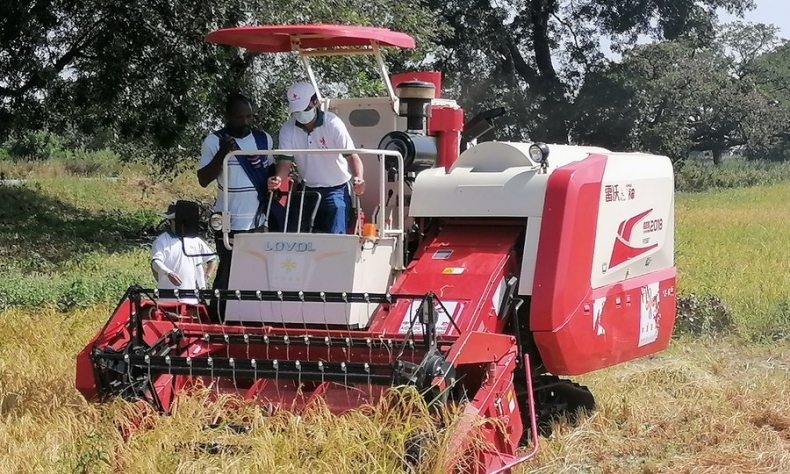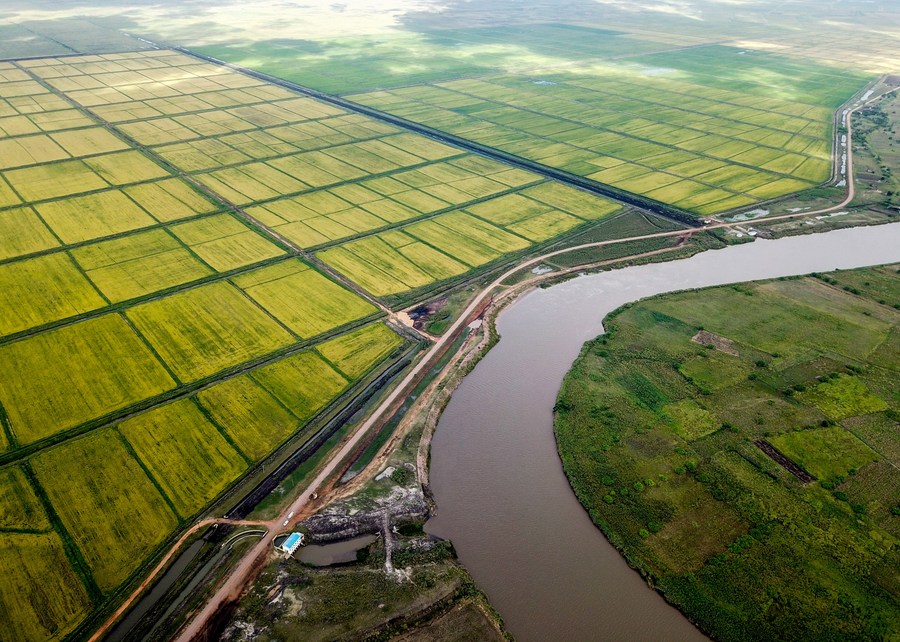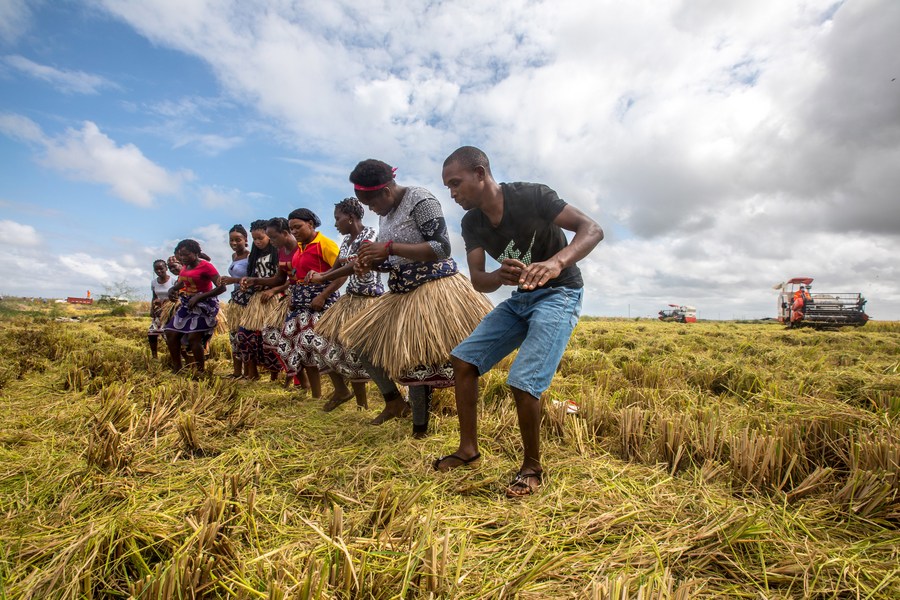A Good Harvest

Sino-African agricultural cooperation in diverse fields is bearing fruit in the new era.
The 20,000-ariary bank note, the largest denomination of money in use in Madagascar, carries the image of a local field of Chinese hybrid rice. This is a celebration of agricultural cooperation between China and Madagascar. The biggest island in Africa is home to about 28 million people, over 80 percent of whom work in agriculture. Nevertheless, according to the World Food Programme, a large percentage of its rural population remains vulnerable to seasonal food insecurity. Aiming to solve the problem, the Chinese government established an agricultural demonstration centre in 2007 in Mahitsy, a commune northwest of the capital Antananarivo, to offer technical support for cultivating hybrid rice.
Madagascar now boasts the largest area of the highest-yielding hybrid rice plantation in Africa, thanks to the diligent efforts of local farmers and Chinese expert groups. It has also become the first African country to have achieved the development of the entire industrial chain of hybrid rice: seed selection and production, planting, processing and sales. The country is making steady progress towards self-sufficiency in rice.
But the China-Madagascar partnership is far from unique. Statistics from China’s Ministry of Agriculture and Rural Affairs (MARA) show that 23 agricultural demonstration centres have already been constructed in 22 African countries. More than 50,000 people have received training from specialist teams dispatched to the continent during the last 10 years.
Liu Yuxi, the Chinese government’s special representative for African affairs, said in his keynote address at the China-Africa Harvest Night on 5 November in Beijing, “China-Africa agricultural cooperation has in fact achieved fruitful results and brought tangible benefits to the African people since the establishment of the Forum on China-Africa Cooperation (FOCAC) in 2000, particularly in the past 10 years.” Diplomats from more than 30 African countries in China, Chinese experts and representatives of international organisations gathered at the event to review China-Africa agricultural cooperation in the new era.
Lin Huifang, deputy director general of the Foreign Economic Cooperation Centre under MARA, pointed out that Sino-African agricultural cooperation has become much more diversified in recent years. “Apart from the traditional forms such as food assistance, sending experts and building demonstration centres, China-Africa agricultural cooperation also includes investment and trade,” Lin told ChinAfrica on the sidelines of the event.

Increasing agricultural investment
Matilde Filomone Mariquele was born and raised in Xai-Xai District of the southern province of Gaza in Mozambique. The mother of five never thought that cultivating rice would be able to support her family. In fact, the majority of the land in her hometown remained uncultivated because of lack of infrastructure, such as an irrigation system.
The situation changed in July 2011 when the Chinese-backed Wanbao Mozambique rice farm, named after the company in charge of this project, was established. In a short period of time, wild grass was eliminated, ditches were filled, irrigation canals were created, and pumping stations were constructed. A total of 2,000 hectares of land have been rehabilitated altogether. This has prompted many locals, including Mariquele, to enthusiastically begin rice planting.
Farmers enter into planting and sales contracts with the company, which in turn makes an initial investment for infrastructure and other inputs like production machines and equipment of cutting-edge technology like drones. These enable farmers to spray pesticides with 25 times the effectiveness of manual labour.
Yields in the farm have progressively risen as a result of upgraded irrigation infrastructure and effective management. In recent years, they have increased from 1.5 tonnes per hectare to up to 9 tonnes per hectare. “My living conditions have significantly improved as a result of the advantages I’ve gotten from growing rice. My children attend school, and I constructed my own home,” Mariquele remarked.
The farm is in fact China’s largest investment project in rice growing in Africa and helps to provide food security in Mozambique with its high yields. According to MARA data, Chinese investment in African agriculture has increased significantly during the last 10 years. Chinese enterprises spent $1.67 billion in two-thirds of the African nations by the end of 2020, with more than 100 agricultural projects receiving investments totalling more than 5 million yuan ($710,200).
“Since agriculture involves long-term commitment, you must patiently wait for a return on your investment. Projects like the Wanbao Mozambique rice farm demonstrate China’s desire to expand its partnership with Africa,” Su Jian, former ambassador of China to Mozambique, said.

Access to the Chinese market
Food security in Africa is frequently jeopardised by an undeveloped agricultural sector and barriers to market access, as noted at the event by Winfred Nii Okai Hammond, Ghana’s ambassador to China. As a result, China has developed many ways to encourage the imports of agricultural products from Africa in recent years.
During the just-concluded Fifth China International Import Expo (CIIE) in Shanghai, a lot of people were interested in African items, including South African wine, Kenyan avocados, and Zimbabwean coffee. In reality, Chinese consumers have been gradually developing interest in African agricultural products since the inaugural CIIE in 2018 and the first China-Africa Economic and Trade Expo in 2019. Through the TV show The World’s Specialty and e-commerce festivals, African products are becoming known to an even wider public.
To expedite the inspection and quarantine procedure, a “green corridor” was introduced at the Eighth FOCAC Ministerial Conference in November 2021. After only a 24-hour journey, an Angolan lobster can now appear on the table of a Chinese family. Statistics from the General Administration of Customs show that more than 360 different types of agricultural products from Africa have already made it into the Chinese market. China has become the second-largest destination for Africa’s agricultural exports.
To keep this momentum going, China has exchanged letters with 12 African countries since the beginning of this year on the application of zero tariffs to up to 98 percent of products exported to the country.
“China has long been a supporter of international efforts to eradicate poverty and ensure food security. It will provide more assistance to African nations in achieving the AU’s Agenda 2063 and the UN’s 2030 Agenda for Sustainable Development Goals,” said Liu.
 Facebook
Facebook
 Twitter
Twitter
 Linkedin
Linkedin
 Google +
Google +










